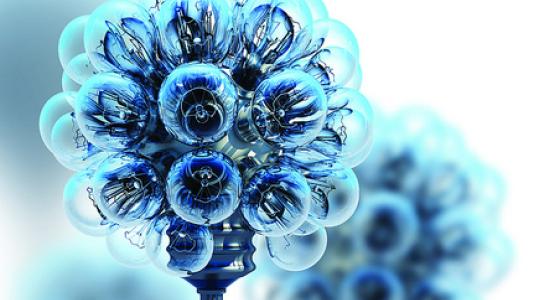
The lab’s research seeks both cleaner energy—solar cells, batteries and biofuels, among others—and ways to reduce man’s environmental footprint, including reducing agricultural runoff and ways to safely clean up contaminated land.
And when it comes to energy, the lab practices what it preaches. A variety of alternative fuels, innovative cooling designs, efficient lighting, and water reduction plans are just the beginning for Argonne: the lab aims to slash its energy consumption by 30 percent by 2015.
The site’s 1,500 acres sometimes even function as a giant laboratory for scientists’ environmental ideas.
For example, the lab’s newest office building will play guinea pig to Argonne mathematician Victor Zavala, who is testing algorithms to reduce buildings’ energy use. Some of the trees on campus are also living labs: a grove of poplars planted by scientist Cristina Negri is testing a method of environmental cleanup called “phytoremediation”, in which fast-growing trees take up pollutants from the ground. (Argonne also plants about thirty new trees on site every year—native species to our Illinois prairie-forest landscape, such as burr oak, are adapted to the area and don’t need much extra water or care to thrive.) A solar array installed at the lab will soon provide both power to lab and employee-owned electric cars and also data on smart-charging technologies.
In honor of Earth Day, visit the lab’s Sustainability Initiative website, and read more stories on Argonne’s green research below.
Environment
Argonne cleans contaminated Kansas site by feeding bacteria
When cleaning the bathroom, we usually consider bacteria the enemy. However, a new Argonne study has shown how to enlist bacteria in the fight to cleanse some of the country’s most intractably polluted locations.
Argonne scientists seek natural remediation for uranium-rich sites
While most of us are focused on life above ground, scientists at Argonne are trying to understand the drama unfolding beneath our feet.
Roadsides, contaminated fields could be unlikely solutions to fuel shortages, water pollution
The lonely, weed-choked roadsides along America’s highways may offer an unexpected solution to two of the biggest issues facing the U.S. today: fuel shortages and water pollution.
Energy
Argonne gets wind of new energy models
Sailors and golfers aren’t the only people interested in knowing how much the wind blows; people who run wind farms need to know too.
Argonne launches unique research initiative to realize solar energy’s full potential
Dozens of researchers at Argonne are exploring new solar technologies as part of an Alternative Energy & Efficiency Initiative.
Argonne helps the grid get smart
Argonne scientists work to help develop a “smart grid” that will not only adapt in real-time to handle larger electricity loads, but also operate more cheaply and efficiently than the existing grid.
Tribal internship students energize alternative fuel science
Argonne and the U.S. Department of the Interior are working together to help future tribal leaders learn about energy resource development and environmental evaluations.
Campus-wide efforts
Green goal: Argonne wins federal award for energy savings
Argonne won a 2010 Federal Energy and Water Management Award for its aggressive energy savings plan, which relies on in-house personnel to find creative ways to reduce energy.
BuildingIQ makes Argonne smarter about energy management
Growing up in Mexico, Argonne scientist Victor Zavala saw energy in a different light. Electricity was expensive and scarce. Heating and cooling systems were not commonplace, and climate control had more to do with putting on a sweater or wearing shorts than adjusting a thermostat.
